Ever found yourself wishing your small space could do more without feeling cramped? Small room design ideas are gaining popularity because they showcase how clever layout, smart storage, and creative decor can make even the tiniest rooms feel open, functional, and inviting.
In this article, you’ll discover a variety of inspiring ideas that blend style with practicality. From space-saving furniture to clever color schemes and thoughtful organization tips, these ideas will help you maximize every inch of your small rooms, turning them into versatile and beautiful spaces you’ll love to spend time in.
1. Multi-Functional Furniture with Hidden Storage Solutions
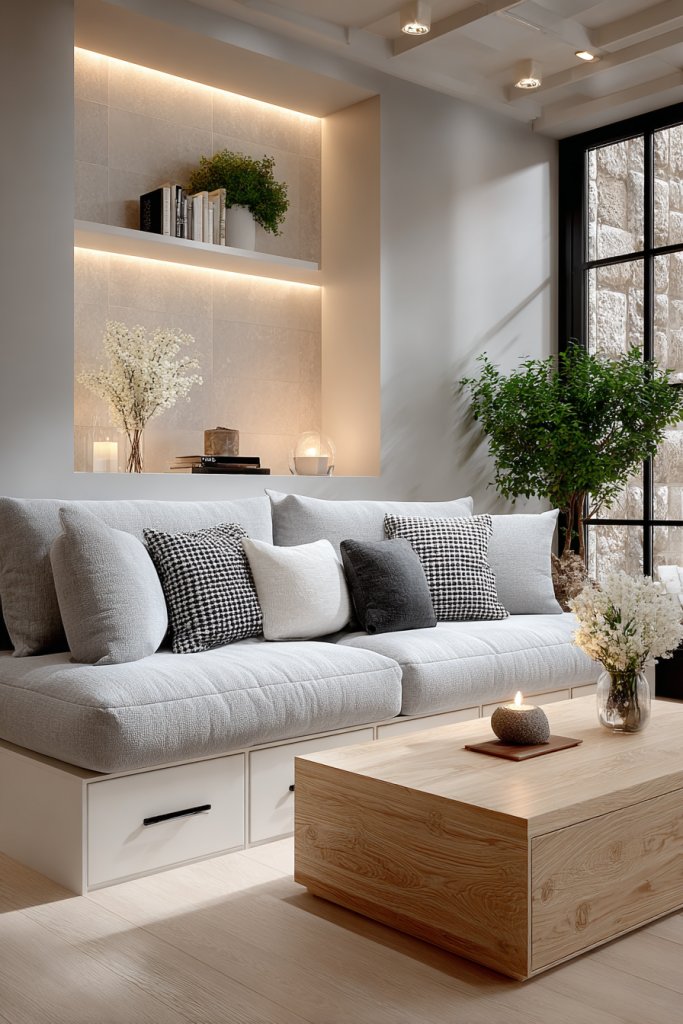
Living in a small space often feels like a constant battle against clutter. You want your home to be cozy and functional without sacrificing style. Multi-functional furniture offers a simple fix—maximize every inch while keeping things tidy. It’s perfect for those who crave efficiency but hate sacrificing aesthetics.
Imagine a plush ottoman with a lid that lifts to reveal hidden storage for blankets and magazines. Visualize a sleek bed frame with built-in drawers, seamlessly blending into your decor. Picture a fold-out desk that tucks away when not in use, leaving a tidy room. These pieces combine form with function, transforming your space into a clutter-free oasis.
Choose furniture that matches your style—minimalist, rustic, or industrial—while serving multiple purposes. In colder months, swap out cushions for plush covers, and in summer, opt for lighter fabrics. For small bedrooms, prefer wall-mounted fold-away desks, while larger rooms can handle bigger storage beds. Flexibility is key to adapting this idea to your lifestyle.
Start by measuring your space and identifying clutter hotspots. Look for furniture with built-in storage compartments or hidden drawers. Prioritize quality pieces that withstand daily use and weight. Use tools like a level and tape measure to ensure proper placement. Assemble carefully, following manufacturer instructions, and consider professional help for complex setups. Incorporate modular designs if you want future flexibility.
Personalize your multi-functional pieces with decorative textiles, like colorful throws or patterned cushions. Add labels or baskets inside drawers to keep things organized. Use different textures—soft velvets or rugged linens—to suit your style. Consider spray-painting or refinishing furniture to match evolving decor themes. The goal is to create an inviting, personalized space that works for you.
Embracing multi-functional furniture can elevate your home’s practicality and style. It proves that small spaces can be both beautiful and efficient. With a little creativity, you’ll turn everyday furniture into clever storage solutions. Ready to declutter and enhance your living area with these smart pieces?
2. Vertical Wall Shelving for Extra Storage and Display
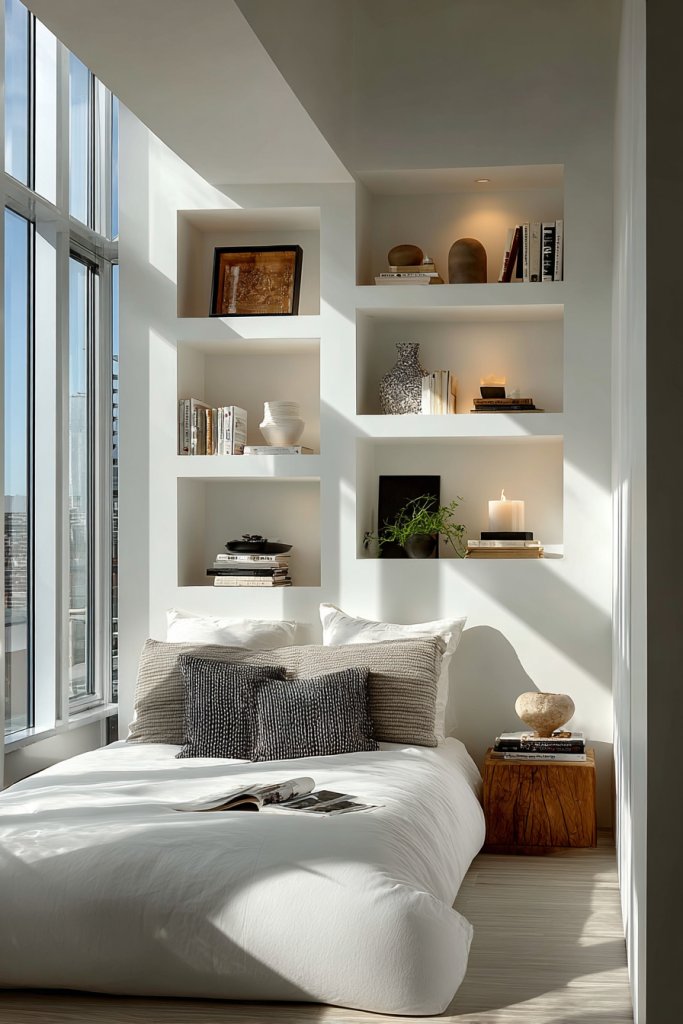
In tiny rooms, floor space is precious, yet you still want places to store and showcase your favorite items. Vertical wall shelving offers a smart way to add storage without eating into your limited floor area. It’s perfect for displaying everything from books to decorative objects, making your walls work harder for you.
Imagine a wall filled with sleek, open shelves in a matte black finish, holding colorful books, small plants, and textured boxes. Visualize a series of floating wooden planks creating a layered effect, adding depth and interest. The space feels open and organized, with everything in easy reach. The shelves add a modern touch while maximizing vertical space.
Mix and match shelf styles—metal, wood, or glass—to suit your decor. For a cozy vibe, use warm-toned woods with decorative brackets. In a contemporary space, opt for minimalist, frameless shelves. Adjust shelf height based on what you plan to display, and consider adding hooks beneath for hanging items. Seasonal decor swaps can keep the display fresh without clutter.
Start by choosing the right wall and measuring available space. Use a level to mark where shelves will go, ensuring they’re straight. Install anchors and brackets suitable for your wall type—drywall, brick, or plaster. Secure shelves firmly, and arrange items thoughtfully. Use a mix of storage baskets and decorative boxes to keep clutter at bay, and balance visual weight across the wall.
Add personal touches by painting the back panel of open shelves in bold or pastel shades. Incorporate decorative items like vintage finds or textured ceramics to create focal points. Consider using LED strip lighting underneath for ambiance. Integrate plants in wall-mounted planters (avoiding overused greenery content) for a lively, fresh look. The key is balancing function with style.
Vertical wall shelving transforms blank walls into functional art displays. It’s an effortless way to free up surface space while adding personality. With a bit of creativity, your walls will become the new focal point. Get inspired to turn vertical space into your personal gallery and storage unit!
3. Lofted Beds for Compact Sleeping and Workspace Areas
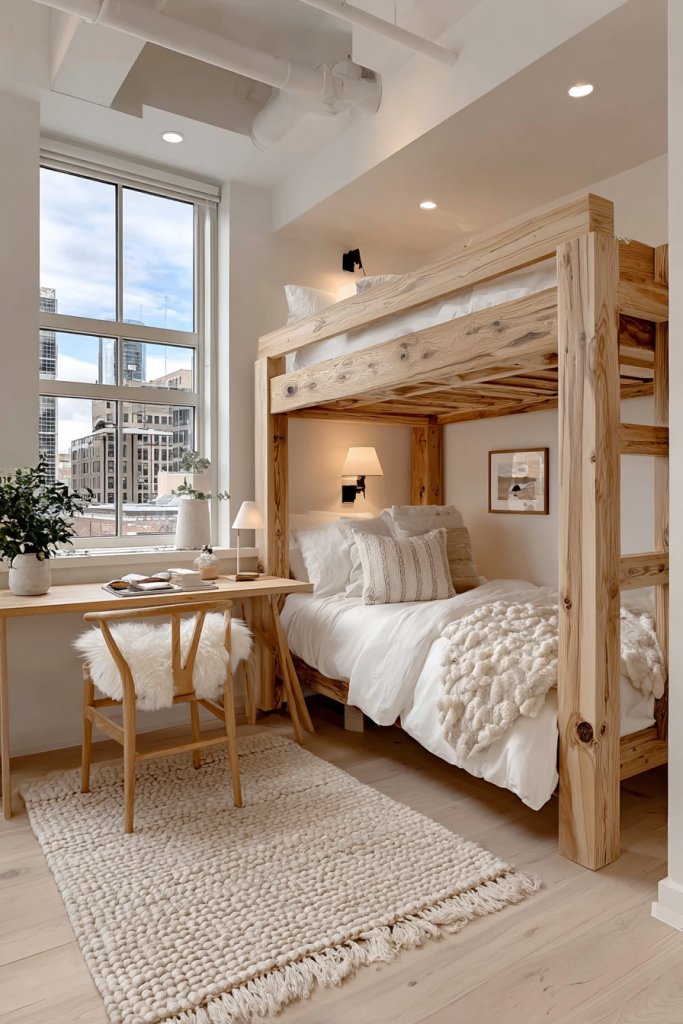
Small rooms often struggle to accommodate both a bed and a workspace, making it hard to keep things organized. Lofted beds lift the sleeping area off the ground, freeing up space underneath. This clever trick turns a single room into a multifunctional haven—sleep and work in harmony.
Picture a sleek metal loft bed painted in matte black, with a cozy mattress topped with textured linens. Underneath, a compact desk with a comfortable chair creates a perfect work nook. The space beneath is accessorized with a soft rug and a small bookshelf, turning a cramped corner into a productivity zone. It feels open, airy, and inviting.
Choose from wood, metal, or composite materials depending on your style preference. For a cozy vibe, opt for warm woods and soft lighting. In minimalist spaces, stick with simple lines and neutral colors. Use the space underneath for a small seating area, additional storage, or a dressing zone, depending on your needs. Seasonal bedding or accessories can also change the room’s mood.
Start by measuring your ceiling height and room dimensions to select an appropriate loft bed. Ensure the structure is sturdy and safely secured to the wall or floor. Assemble according to instructions, paying attention to weight limits. Clear the area and prepare a comfortable mattress with quality bedding. Maximize space underneath with a small desk, shelves, or storage bins, depending on your lifestyle.
Decorate with textured throws, geometric rugs, or colorful cushions to add personality. Use wall-mounted organizers or pegboards beneath for tools, supplies, or accessories. Incorporate ambient lighting like string lights or clip-on lamps (avoiding typical pendant or table lamps). Personal touches make the space feel uniquely yours without clutter.
Lofted beds unlock room potential, making small spaces feel larger and more functional. They’re perfect for students, creatives, or anyone craving a versatile room. With this setup, your space becomes a flexible sanctuary that adapts to your changing needs. Ready to elevate your room’s potential?
4. Mirror Placement to Enhance Light and Create Illusion of Space
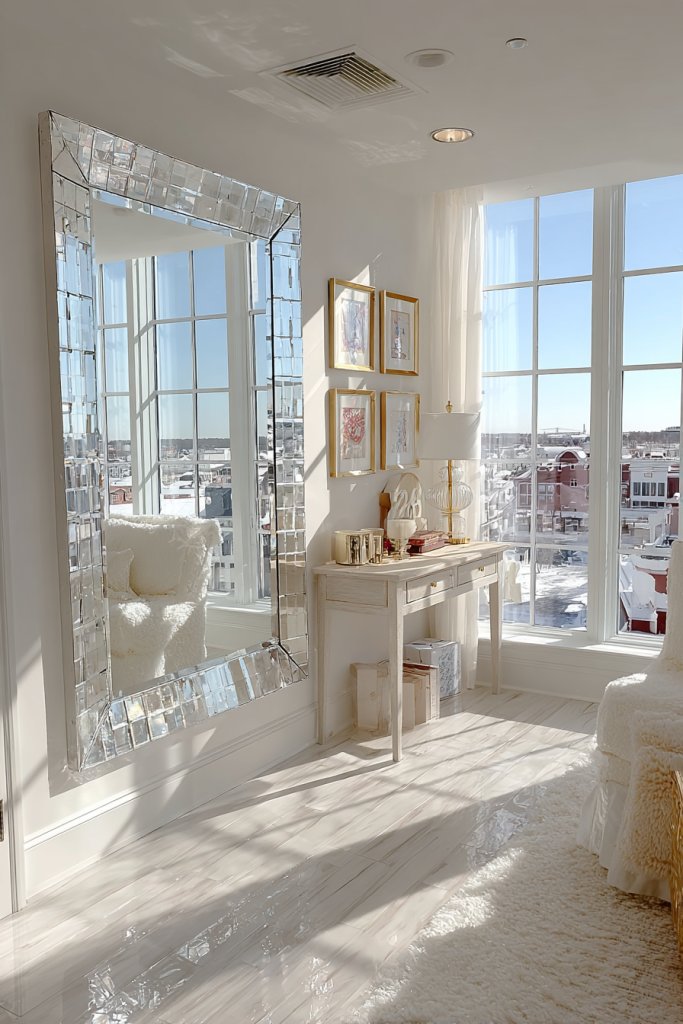
Small rooms can feel dark and cramped, leaving you wanting more light and space. Strategic mirror placement can instantly brighten your room and trick the eye into perceiving a larger area. It’s a simple, budget-friendly trick that makes a huge difference. Who doesn’t want a room that feels more open and airy?
Imagine a large rectangular mirror leaning against a wall, reflecting a sunny window and a cozy reading nook. Or picture a series of smaller, decorative mirrors arranged in a gallery wall pattern, adding depth and visual interest. The reflection amplifies natural light, bouncing it around to illuminate every corner. The result is a bright, expansive feel that transforms your space.
Choose mirrors with decorative frames to match your style—be it ornate, minimalist, or rustic. Position mirrors across from windows or light sources to maximize reflection. For smaller rooms, a large mirror on one wall creates a focal point and doubles the perceived size. Use mirrored closet doors or wall-mounted options to save space and add functionality.
Identify the best wall for mirror placement—facing windows or opposite existing light sources. Secure heavy mirrors with appropriate anchors to prevent accidents. Consider tilting or leaning mirrors for a casual look, or wall-mount for a sleek appearance. Play with angles to catch light differently, and ensure the mirror is at eye level for the best effect. Keep mirrors clean to maintain brightness and clarity.
Frame your mirrors in materials that complement your decor—wood, metal, or painted finishes. Use decorative tape or trim for a DIY touch. Combine multiple mirrors of different shapes and sizes for an eclectic vibe. Add small LED strips behind the frames for ambient glow, or layer a mirror with artful textiles nearby. The goal is a reflective focal point that enhances your room’s personality.
Mirrors are more than just reflective surfaces—they’re magic tools for transforming your space. With clever placement, you can create a brighter, more spacious environment that feels twice as big. It’s an easy update that boosts confidence in your interior styling skills. Give it a try and watch your room come alive!
5. Compact Fold-Down Tables for Dining or Work Zones
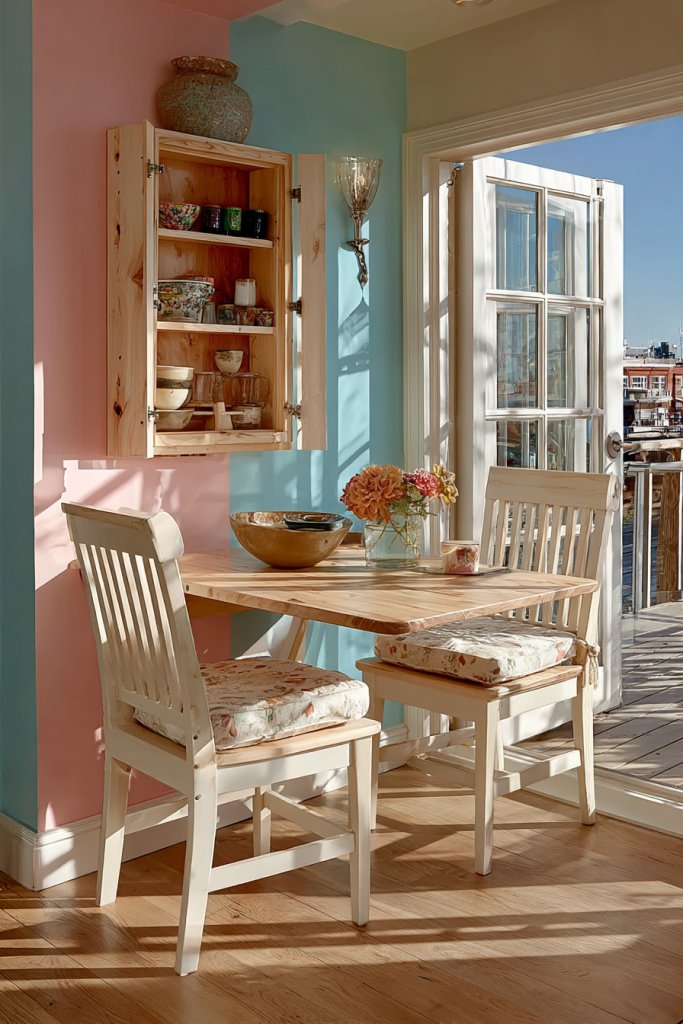
Limited space often means sacrificing dining or workspace, but not anymore. Fold-down tables provide a versatile solution that frees up valuable floor area when not in use. It’s like having an extra room—without the extra square footage. Who doesn’t love multi-use furniture?
Imagine a sleek wall-mounted table, folded flat against the wall, ready to serve as a dining surface or work desk. When needed, it folds down smoothly to reveal a sturdy surface in a modern finish. Paired with comfortable chairs or stools that tuck underneath, it creates a cozy, functional corner. The space feels open and uncluttered when the table is tucked away.
Choose from various styles—minimalist, rustic, or contemporary—to match your decor. Use durable materials like laminated wood or metal for longevity. Opt for fold-down tables with adjustable height or extendable features for added versatility. Decorate with lightweight accessories and use cushions or mats to add comfort and style. Seasonal decor can also be swapped easily.
Start by selecting a suitable wall that can support the table and withstand frequent use. Mount the table with heavy-duty brackets, following manufacturer instructions. Ensure the wall anchors are appropriate for your wall type. Test the mechanism several times to ensure smooth operation. When folding down, make sure the table is level and secure. Keep tools and hardware handy for adjustments.
Personalize your table with paint or stain to match your room’s palette. Use colorful or patterned cushions on stools for added personality. Add wall-mounted storage beneath or nearby for essentials like stationery or cutlery. Incorporate decorative elements like a small clock or a sleek organizer to make the zone more inviting. The goal is a seamless blend of style and function.
Fold-down tables are a smart, space-saving solution that can adapt to your needs. They prove that small spaces can be highly functional without sacrificing style. With a little planning, you create a flexible area perfect for eating, working, or even crafting. Ready to maximize your small room’s potential?
6. Under-Window Seating with Built-In Storage

Small rooms often lack cozy corners for relaxing or reading, especially near windows. Under-window seating offers a comfortable spot while also solving storage issues. It’s a win-win—seating and hidden storage in one sleek package. Who wouldn’t want a cozy nook that keeps clutter out of sight?
Picture a cushioned window seat with soft, textured fabric in a calming hue, nestled beneath a large window. Storage drawers or cabinets are built into the base, hiding blankets, books, or accessories. The seat is topped with decorative pillows in contrasting colors and patterns. Natural light floods the space, making it inviting and functional. It’s a perfect corner for quiet mornings.
Use different upholstery fabrics—linen, velvet, or cotton—to match your decor style. Incorporate open shelves or cubbies on the sides or underneath for extra storage or display. For seasonal changes, swap out cushions and throws to refresh the look. Customize the cabinetry with paint or wallpaper to add personality. The seating can also double as a workspace with a small lap desk.
Measure the width and height of your window area to ensure a snug fit. Build or buy a bench with a hinged top or drawers for storage. Use durable, easy-to-clean materials for the seat cushion. Secure the base to the wall if needed for stability. Organize stored items inside baskets or bins to maintain a tidy appearance. Add decorative pillows for comfort and style.
Add decorative trims or piping to your cushions for a polished look. Use removable covers to change colors seasonally. Incorporate small LED reading lights or fairy lights for ambiance (avoiding traditional lamps). Personalize with small trinkets or framed photos on nearby shelves. The goal is a cozy, functional zone that reflects your personality.
Under-window seating turns an overlooked space into a charming retreat. It combines comfort with practicality, making your room feel larger and more inviting. With a little DIY or smart shopping, you can create a custom nook tailored to your needs. It’s a simple upgrade that makes a big difference in your daily life.
7. Floating Desks for Minimalist Workstations
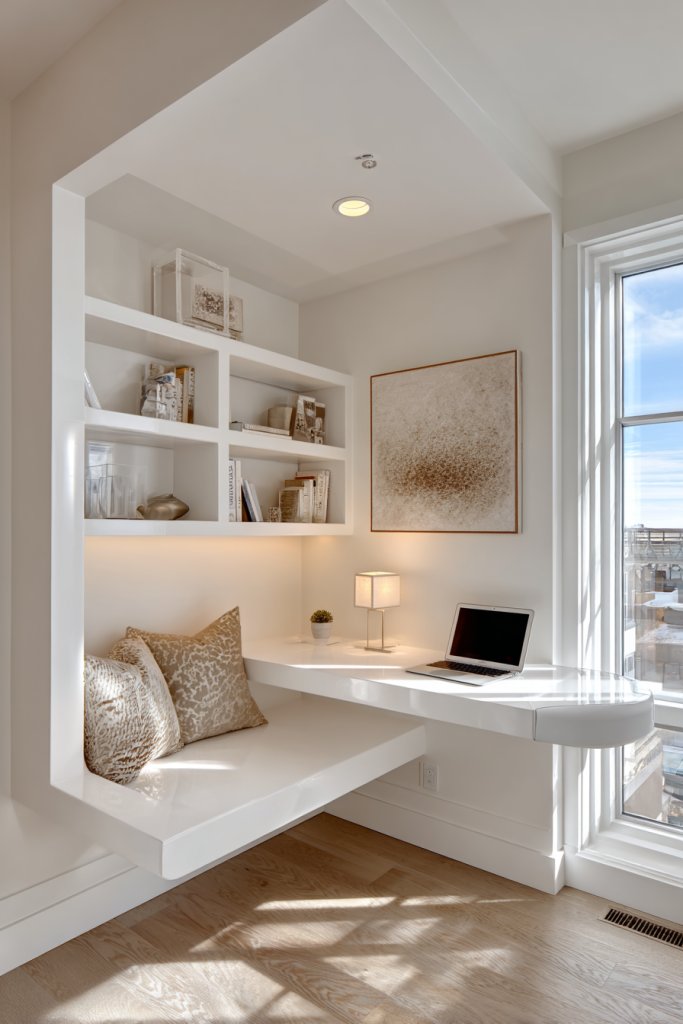
Cluttering your room with bulky desks defeats the purpose of a small space. Floating desks offer a minimalist solution that frees up floor area while providing a functional workspace. They’re perfect for those who want a clean, sleek look without sacrificing productivity. Who says small can’t be mighty?
Visualize a thin, wall-mounted desk with a smooth finish in a neutral tone, seamlessly blending into the wall. When folded up, it becomes almost invisible, leaving space for movement or other furniture. When in use, it provides enough surface for a laptop, notepad, and essentials. Paired with a floating shelf or pegboard, it creates a tidy, modern workspace.
Choose from materials like wood veneer, MDF, or metal for durability and aesthetics. For a Scandinavian look, opt for light-colored wood with simple hardware. Adjust the desk size based on your needs—small for occasional use, larger for daily tasks. Complement with wall-mounted organizers or cable management solutions for a clutter-free experience.
Identify a sturdy section of wall that can support the weight of your desk. Use a level to mark the mounting points, and secure with appropriate wall anchors. Install the desk according to manufacturer instructions, ensuring it is flush and stable. Clear the workspace of debris and organize cords and accessories for a clean look. Consider adding fold-out or extendable features for flexibility.
Add a pop of color with a vibrant desk mat or decorative accessories. Use wall-mounted storage above for supplies, minimizing surface clutter. Incorporate a small corkboard or magnetic strip nearby for notes and reminders. Personal touches like a favorite quote or artwork can make the space uniquely yours.
Floating desks exemplify how smart design can maximize functionality in small rooms. They boost your productivity while maintaining a sleek, uncluttered look. With a little DIY or careful shopping, you can craft a workspace that motivates you every day. Ready to make your room work smarter?
8. Clever Closet Organization with Adjustable Shelves
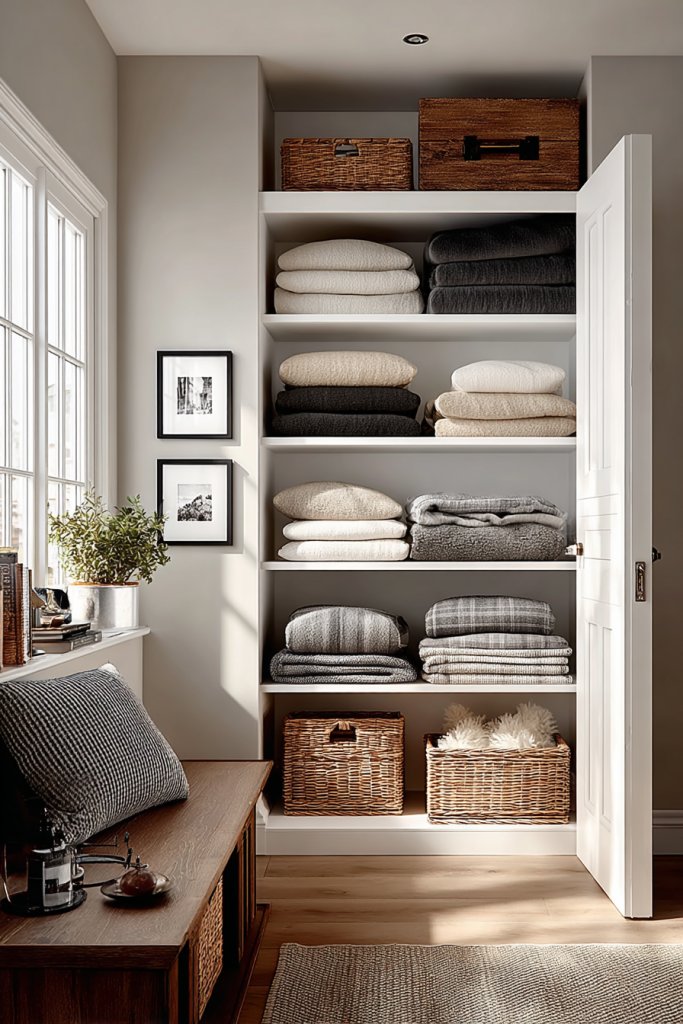
Closets in small rooms often become dumping grounds, making it hard to find what you need. Adjustable shelves turn chaos into order, giving you flexible storage that adapts to your wardrobe. It’s a game-changer for maximizing space and keeping everything accessible. Who doesn’t want a tidy closet?
Imagine a closet with sleek, modular shelves in a matte finish, neatly holding folded sweaters, shoes, and accessories. The shelves can be repositioned easily, accommodating changing wardrobe sizes or seasonal items. Clear plastic bins or labeled baskets keep smaller items organized. The entire closet looks tidy, inviting, and easy to maintain.
Mix open and closed storage—think baskets or drawers for smaller items, shelves for bulkier pieces. Use different heights and depths to fit various clothing types and accessories. Incorporate pull-out racks or hooks for accessories like belts and scarves. Seasonally, swap or reconfigure shelves to suit your wardrobe changes. Personalize with color-coded bins or decorative labels.
Start by measuring your closet’s dimensions carefully. Choose adjustable shelving systems that fit your space and style. Install brackets securely into wall studs or anchors for stability. Organize items by category, and use matching containers for a cohesive look. Regularly reassess and reconfigure shelves to keep the system flexible. Consider adding a full-length mirror or lighting for convenience.
Decorate with patterned baskets or colorful labels to add personality. Use velvet-lined compartments for jewelry or delicate accessories. Incorporate small fabric drawers or hanging organizers for additional storage. Keep the space clutter-free by donating unused items regularly. The result is a closet that feels organized and inspiring.
An organized closet boosts your confidence and simplifies your routines. It shows that small spaces can be functional and beautiful with a little effort. Reconfigurable shelving means your closet can evolve with your wardrobe. Get ready to open the door with pride every day!
9. Space-Saving Corner Shelves and Units
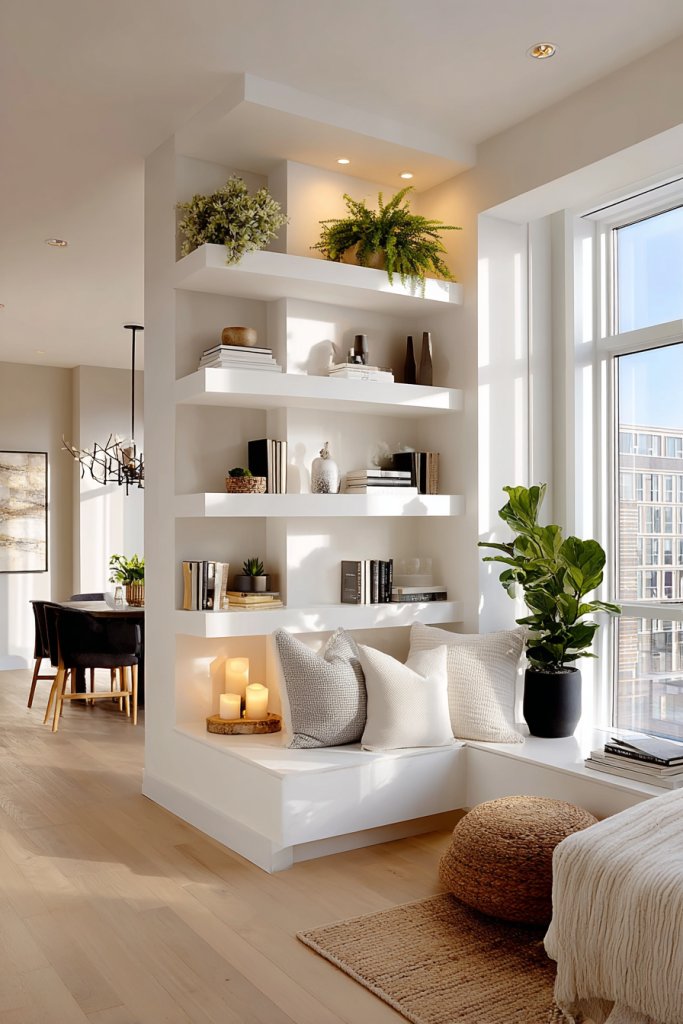
Corners are often wasted space in small rooms, turning into dead zones. Corner shelves and units turn these awkward spots into valuable storage and display areas. They’re perfect for maximizing every inch of your room without cluttering the main space. Who knew corners could be so useful?
Picture a tiered corner shelf with a combination of open shelves and small drawers, holding books, decor, and everyday items. The angular design fits snugly into the corner, making the most of vertical space. Warm wood tones contrast with a cool wall color, creating a cozy nook. The shelves add depth and visual interest without overwhelming the room.
Choose between open or enclosed units, or a mix of both, depending on your needs. Use angular or curved designs to soften sharp corners or match your decor style. Layer items of different heights and textures for visual appeal. Seasonal accessories or decorative objects can be rotated to keep the space fresh. Small baskets or containers help organize smaller items.
Measure your corner space accurately, including height and depth. Select a unit that fits your style and storage needs. Secure the unit to the wall with appropriate brackets or anchors for safety. Arrange items thoughtfully, balancing visual weight and accessibility. Keep frequently used items at eye level or within easy reach. Regularly dust and reorganize to maintain a tidy look.
Paint or stain the shelves to match your decor palette. Incorporate decorative objects like vintage collectibles or textured ceramics (avoiding wall art). Use small LED puck lights or battery-operated candles for ambiance. Personalize with labels or tags for organized storage. The goal is a functional, attractive corner that adds character.
Corner shelves are a clever way to make small rooms more functional and stylish. They help you utilize every nook, making the space feel larger and more organized. With creative styling, your corners can become the highlight of your room. Start transforming those unused spaces today!
10. Use of Light, Neutral Colors for a Bright, Open Feel
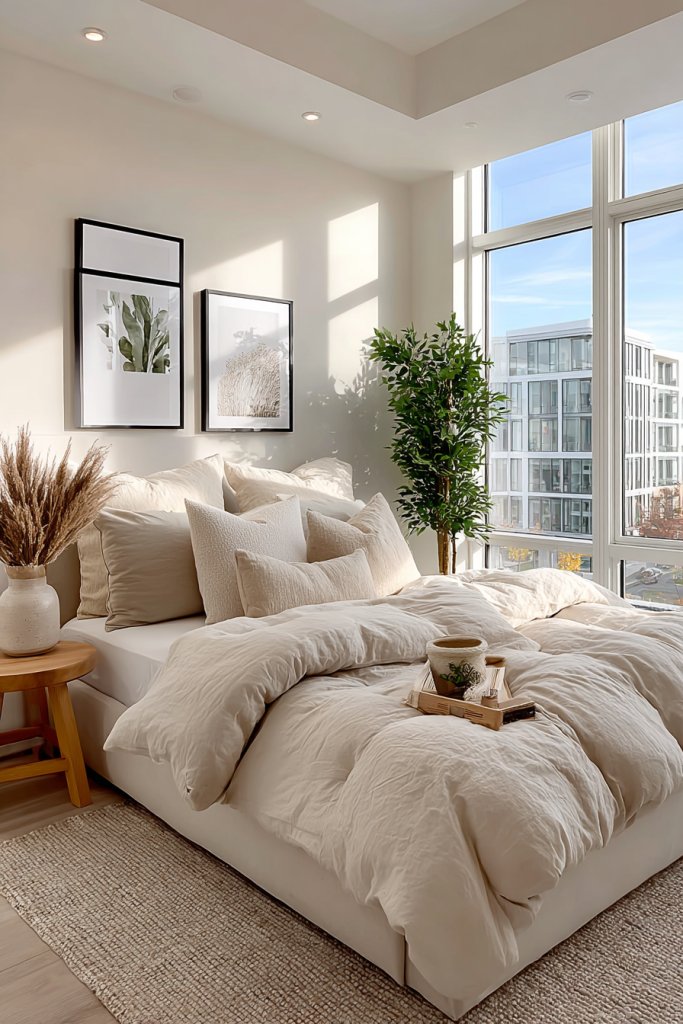
Dark, saturated colors can make small rooms feel cramped and gloomy. Light, neutral hues open up space visually and reflect more natural light. They create a calm, airy environment that feels larger than it is. If you want your small room to breathe, this is your go-to trick.
Imagine soft beige walls paired with crisp white trim, creating a seamless, expansive backdrop. Light-colored furniture, like a cream sofa or pale wood accents, enhances the airy feel. Textured fabrics in pastel shades add warmth without overwhelming. Natural light bouncing off these surfaces makes the room glow, instantly uplifting the mood.
Choose from shades like soft gray, warm taupe, or icy blue—whatever suits your style. Keep furniture in similar light tones for cohesion or add pops of color with accessories that are easy to swap out. Use matte or satin finishes to reduce glare and keep the space feeling calm. Seasonal updates can include adding darker accents or textiles for contrast.
Start with painting walls in a light, neutral color that complements your flooring. Use light-colored or transparent window treatments to maximize daylight. Opt for furniture with slim profiles and soft hues. Incorporate different textures—knits, linens, cottons—to add depth without visual clutter. Use mirrors and reflective surfaces strategically to amplify light.
Layer textiles like throws, cushions, and curtains in coordinating neutrals. Incorporate metallic or matte finishes in fixtures or decor to add subtle sophistication. Keep clutter to a minimum, and avoid heavy, dark furniture. Use art or decorative objects sparingly to maintain a clean, cohesive look. The focus is on creating a serene, spacious vibe.
Light, neutral palettes are timeless and versatile, making your room adaptable for any style. They help small spaces feel open, fresh, and inviting. With simple color choices, you set a foundation for ongoing decorating flexibility. You’re just a paintbrush away from transforming your space into a bright sanctuary.
11. Slim Profile Furniture with Narrow Legs or Compact Designs
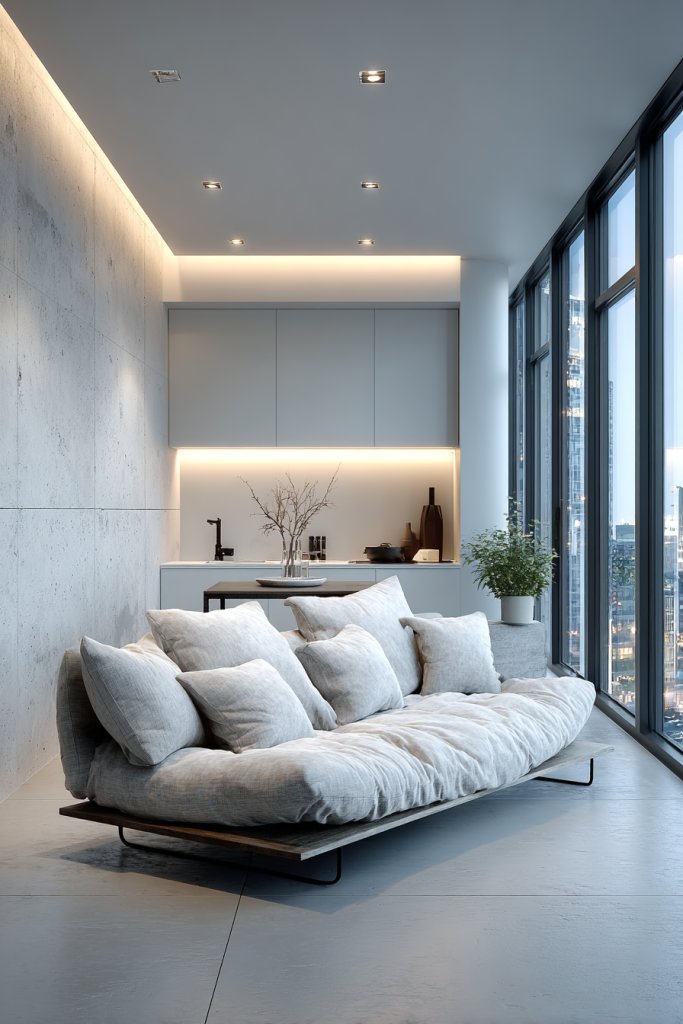
Bulky furniture can swallow up small rooms, making them feel even tighter. Slim profile furniture with narrow legs or compact designs creates a sense of openness and flow. It’s a simple way to keep your space feeling airy while still functional. Who wants to feel boxed in?
Picture a sleek sofa with slender metal legs, giving the illusion of more space beneath. A compact coffee table with a glass top and thin legs allows light to pass through, reducing visual weight. Minimalist shelving units with slim profiles add storage without crowding the room. The overall effect is a balanced blend of openness and function.
Opt for furniture with tapered or spindly legs in metal or wood finishes. Choose multi-purpose pieces—like a narrow sideboard that doubles as a workspace. Small-scale furniture allows for more flexible layouts, accommodating different needs. Pair with delicate textiles and light-colored accessories to enhance the sense of space.
Assess your room’s dimensions and choose furniture with slim profiles accordingly. Prioritize lightweight, movable pieces for easy rearrangement. Use furniture with open bases or legs that elevate off the floor to create a feeling of openness. Keep pathways clear and avoid oversized pieces that dominate the room. Regularly reassess furniture arrangement for best flow.
Add personal touches with colorful cushions or textured throws to soften the minimalist look. Incorporate decorative accessories that are small and lightweight. Use rugs or curtains to add warmth and personality without adding bulk. Stick to a cohesive color palette to keep the space feeling unified.
Slim profile furniture proves less is more—perfect for small spaces craving simplicity and elegance. It creates an open, breathable environment that invites relaxation. With thoughtful choices, small rooms can feel surprisingly spacious and stylish. It’s time to embrace sleek, lightweight furniture!
12. Layered Lighting with Task, Ambient, and Accent Lights
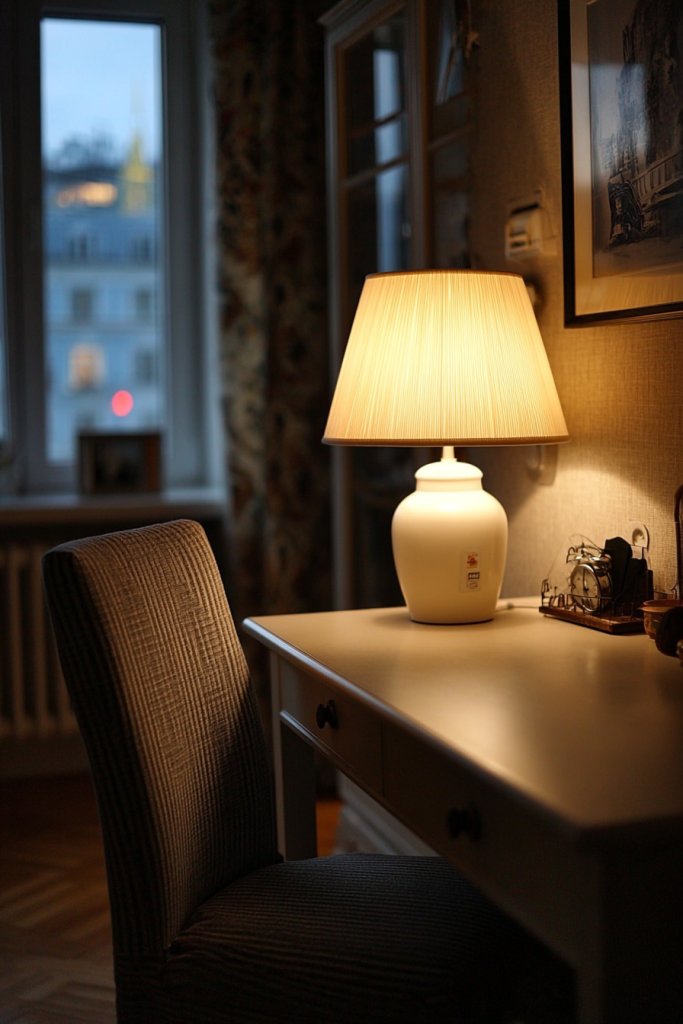
A small room with poor lighting feels dark and uninviting, killing any sense of space. Layered lighting—combining task, ambient, and accent lights—brightens up the room and adds depth. It’s a simple way to make your space more functional and visually appealing. Who wants a gloomy nook?
Imagine a room with soft overhead LED panels, warm table lamps on side tables, and dedicated reading lights beside the bed. The warm glow creates a cozy atmosphere, while focused task lighting helps you work or read comfortably. Accent lights highlight artwork or architectural features, adding visual interest. The layered approach makes the room feel welcoming and versatile.
Mix different light sources—dimmer switches, sconces, or strip lighting—to control ambiance. Use warm white bulbs for a cozy vibe or cooler tones for productivity. Incorporate decorative fixtures like vintage sconces or modern pendants (avoiding overused pendant lights). Adjust lighting based on time of day or mood. Seasonal lighting changes can refresh the space.
Plan your lighting layout based on activities and focal points. Install ceiling fixtures with dimmers for overall illumination. Add task lighting near desks, beds, or reading areas. Use plug-in or hardwired accent lights to highlight shelves, artwork, or architectural details. Layer different types of lights to create a balanced, inviting environment. Regularly check and replace bulbs for consistent warmth.
Personalize your lighting with smart bulbs or color-changing LEDs for mood control. Incorporate decorative fixtures that match your style, from industrial to boho. Use candles or lanterns for cozy ambiance (without overusing wall art). Keep cords hidden with cable management solutions. The goal is to craft a dynamic, adaptable lighting scheme.
Layered lighting elevates your small room into a multi-dimensional space. It enhances functionality and mood, making every activity more enjoyable. With a few adjustments, you can create a room that feels bigger and more inviting. Light up your space and see the difference it makes!
13. Hanging Baskets or Over-the-Door Organizers for Additional Storage
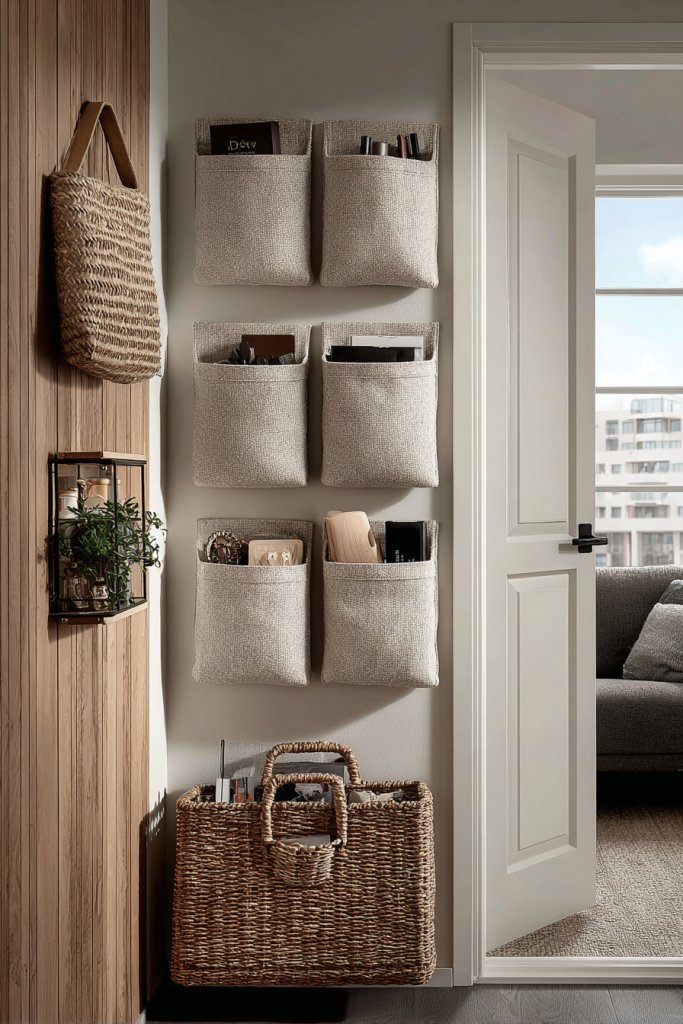
Cluttered small rooms often lack sufficient storage, making organization a challenge. Hanging baskets and over-the-door organizers utilize vertical space efficiently. They’re perfect for small items like accessories, cleaning supplies, or even snacks. It’s a simple upgrade that clears clutter and boosts functionality.
Picture a series of fabric baskets hanging from a sturdy over-the-door rack, holding shoes, toiletries, or craft supplies. They add texture and color to the room while keeping essentials within reach. Over-the-door shoe organizers with clear pockets display your footwear neatly. The space remains open and tidy, with everything easily accessible.
Choose from mesh, fabric, or plastic organizers, depending on your needs and decor. Use color-coded baskets to quickly find items or match your room’s palette. Hang organizers on doors, walls, or inside closets for maximum versatility. Seasonal swaps or reconfigurations keep the space feeling fresh and organized.
Select sturdy over-the-door hooks and organizers that fit your door and wall space. Attach baskets or pockets securely, ensuring they can handle your intended weight. Organize items logically—by frequency of use or category. Regularly clean and declutter to maintain order. Use labels or color coding for quick identification.
Decorate baskets with fabric covers or paint for a personal touch. Use small hooks or clips inside for keys, jewelry, or tools. Incorporate decorative ribbons or trims for added charm. Keep high-traffic items in easily accessible pockets. The focus is on creating a clutter-free, personalized storage zone.
Over-the-door organizers are a quick, affordable way to boost your room’s organization. They turn unused space into strategic storage, making daily routines smoother. With a little creativity, your room can be both functional and stylish. Say goodbye to clutter, and hello to efficiency!
14. Clear Glass or Acrylic Partitions for Visual Separation
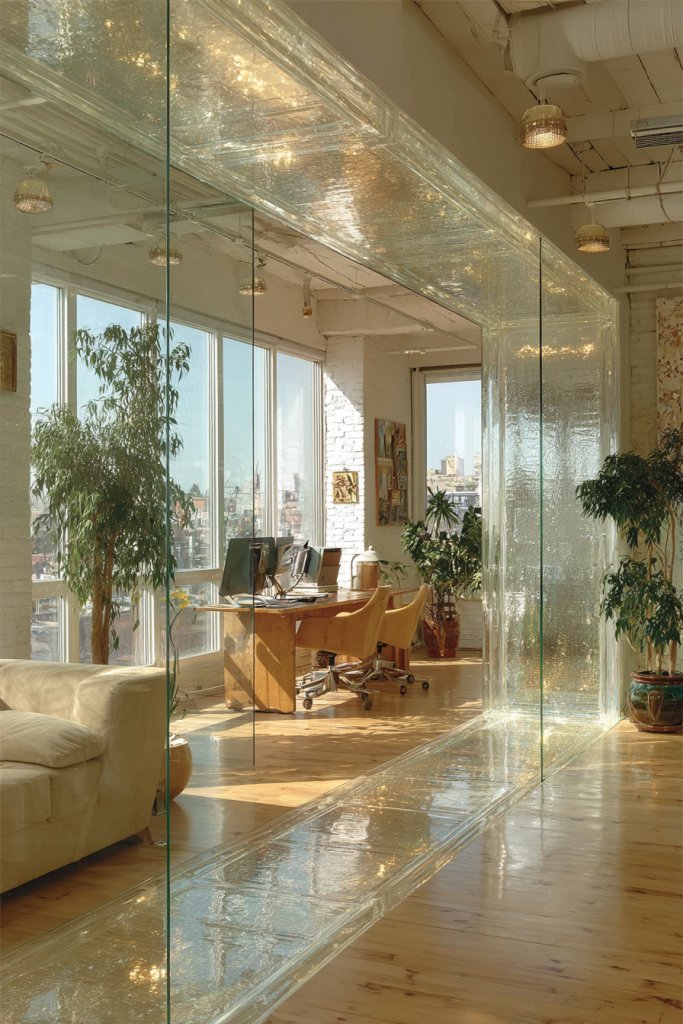
Small rooms often serve multiple functions but lack clear separation, making the space feel cluttered. Clear glass or acrylic partitions divide areas without blocking light or creating visual barriers. They add privacy and structure while maintaining an open, airy vibe. Who says separation has to feel restrictive?
Imagine a transparent acrylic panel dividing a sleeping area from a workspace, with a sleek metal frame. The room still feels spacious, with light flowing freely between zones. A glass partition with frosted sections offers privacy while diffusing light softly. The overall effect is a modern, minimalist aesthetic that enhances spatial perception.
Choose frameless or framed options in materials like tempered glass or clear acrylic. Use decorative films or frosted finishes for privacy without sacrificing light. Install sliding or folding partitions for flexibility. Incorporate metal or wooden accents that complement your decor style. Seasonal or mood-based changes can be achieved with removable film or decals.
Assess your room layout and determine where a partition enhances function without blocking light. Measure carefully, and select the right thickness and type of panel. Secure the partition with appropriate hardware—tracks, hinges, or stands—following safety guidelines. Ensure stability and safety, especially in high-traffic areas. Clean regularly to maintain clarity and shine.
Frame your glass or acrylic with decorative trims or paint accents. Add decals or patterns to customize the look. Use LED backlighting behind the partition for a dramatic effect. Incorporate plants or textiles nearby to soften the overall look—avoiding wall art or artwork content. The goal is sleek separation with a personal touch.
Transparent partitions redefine small spaces by adding structure without sacrificing openness. They’re perfect for creating multi-functional zones in compact rooms. With creative design and proper installation, your space will feel larger, more organized, and stylish. Get ready to elevate your room’s functionality!
15. Foldable or Stackable Seating for Flexible Use
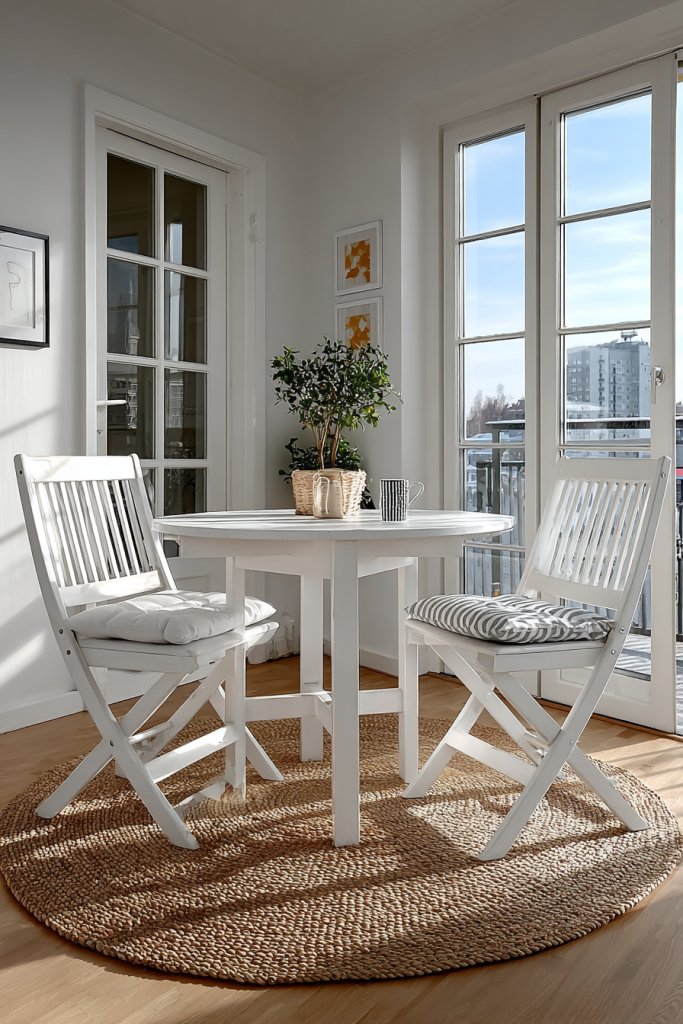
Limited space means your seating options are often limited or permanently in the way. Foldable or stackable chairs and stools offer flexible seating that can be stored away when not needed. They provide comfort and practicality without cluttering your room. Who wants bulky furniture taking up precious space?
Visualize a set of lightweight, colorful stackable stools neatly stacked in a corner. When hosting guests, they easily unfold into comfortable seats, then stack back up to save space. A foldable chair leans against a wall, ready for use during meals or work. These versatile pieces keep your room feeling open and adaptable.
Choose from materials like molded plastic, metal, or wood for durability and aesthetic appeal. Mix and match colors for a playful vibe or stick to neutral tones for a minimalist look. Use foldable or stackable seats in different areas—dining, workspace, or outdoor zones. Seasonal or occasion-based swaps keep things fresh.
Select lightweight, sturdy seating that folds or stacks easily. Store in designated spots, like under a bed or in a closet, to keep the room tidy. Use furniture with locking mechanisms for safety. When in use, set up in a way that doesn’t block pathways. Regularly check hinges or stacking stability for safety.
Add decorative cushions or seat pads to enhance comfort and style. Choose covers that can be washed or changed seasonally. Use matching or contrasting colors to complement your decor theme. Incorporate small storage pockets or trays on the seats for added functionality.
Foldable and stackable seating makes your small space infinitely adaptable. They’re perfect for hosting friends, working, or relaxing without permanent clutter. With a few smart choices, your room stays open, versatile, and inviting. Ready to maximize your space with flexible seating?
16. Minimalist Decor with Functional Art Pieces
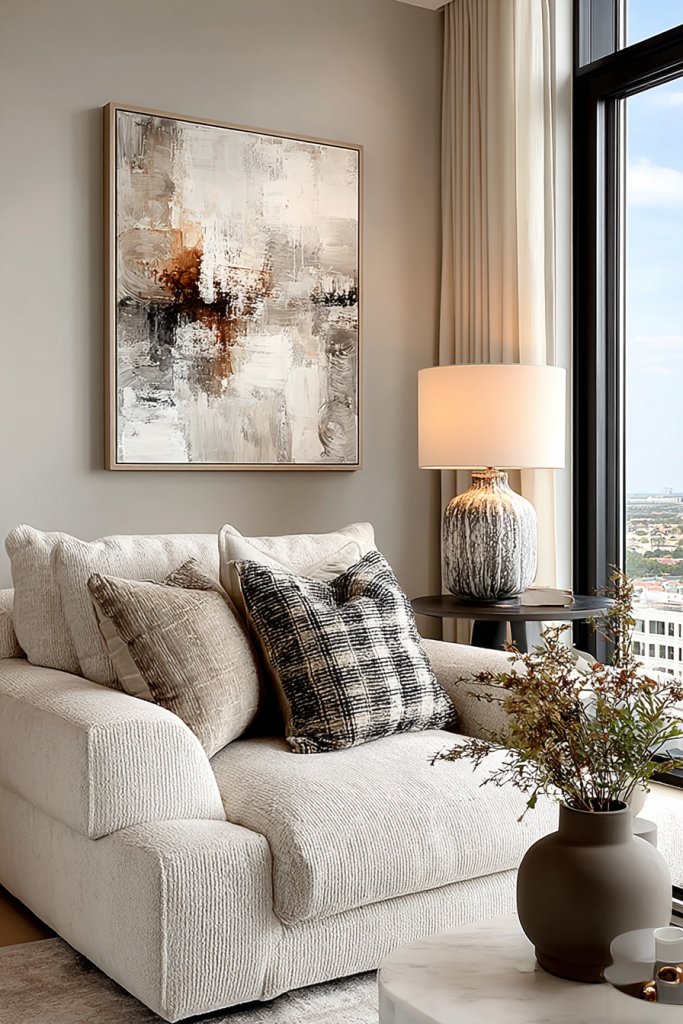
Cluttered decor can make even the largest rooms feel cramped and chaotic. Minimalist decor emphasizes simplicity and functionality, creating a calm, spacious environment. Choosing art pieces that serve a purpose keeps your small room stylish and clutter-free. Less really is more.
Imagine a sleek wall with a simple, geometric sculpture in matte black, serving as both art and a conversation starter. A sculptural light fixture adds visual interest without cluttering surfaces. Functional art like a stylish storage box or a decorative tray helps organize while enhancing the aesthetic. The room feels curated, not crowded.
Opt for clean lines and neutral colors, adding pops of color through textiles or accessories. Choose multi-purpose art—like a mirror with an integrated shelf or a minimalist clock. Use sculptural elements that double as storage or lighting. Seasonal updates can include swapping art or changing textiles to keep things fresh.
Select art pieces that balance form and function, considering size and placement. Hang or display items at eye level for impact. Use wall-mounted storage or decorative trays that double as art. Keep surfaces clear of clutter by incorporating functional decor items. Regularly refresh your selections to maintain a fresh look.
Personalize with handcrafted or unique art objects that reflect your style. Use textured textiles or fabric wall hangings to add warmth and softness. Incorporate modern or abstract art for a contemporary vibe. Keep clutter minimized and focus on a few statement pieces that create visual harmony.
Minimalist decor with functional art proves that style doesn’t have to be complicated. It creates a peaceful, organized environment that invites relaxation and focus. With thoughtful choices, your small room can feel expansive and refined. Simplicity is the ultimate sophistication.
17. Under-Furniture Storage Bins for Clutter-Free Floors

Floors in small rooms often become catch-alls for everything, making spaces look chaotic and unorganized. Under-furniture storage bins provide hidden compartments to hide away clutter. They keep your floors clear and your mind at ease. Who wants to trip over mess every day?
Picture a bed with a low-profile frame and sleek, matching storage bins underneath, holding seasonal clothing or extra bedding. A sofa with built-in drawers conceals magazines, toys, or remote controls. The room looks tidy, with only essential furniture visible. Everything has a designated, hidden spot, making tidying effortless.
Choose bins that match your decor—plastic, fabric, or woven—to suit your style. Use labels or color-coding for easy retrieval. Incorporate bins with lids for a clean look or open bins for quick access. Seasonal or frequent-use items can be stored here, keeping the main space clutter-free. Combine with furniture that has built-in storage for maximum efficiency.
Measure the space under your furniture to select appropriately sized bins. Use durable, easy-to-clean materials that withstand daily use. Place bins strategically for easy access without blocking pathways. Regularly declutter and reorganize to keep the system effective. Consider stacking options or modular bins to optimize space.
Decorate storage bins with removable covers or labels to add personality. Use decorative baskets or woven containers for a more natural look. Incorporate color schemes that complement your room’s palette. Keep frequently used items in visible bins and seasonal items tucked away. The goal is both functional and stylish storage.
Under-furniture storage bins turn hidden space into your best friend. They help you maintain a clutter-free, peaceful environment. With clever organization, your small room stays tidy and inviting. It’s a simple upgrade with big benefits—start today!
18. Compact Rolling Carts for Versatile Storage and Surface Space
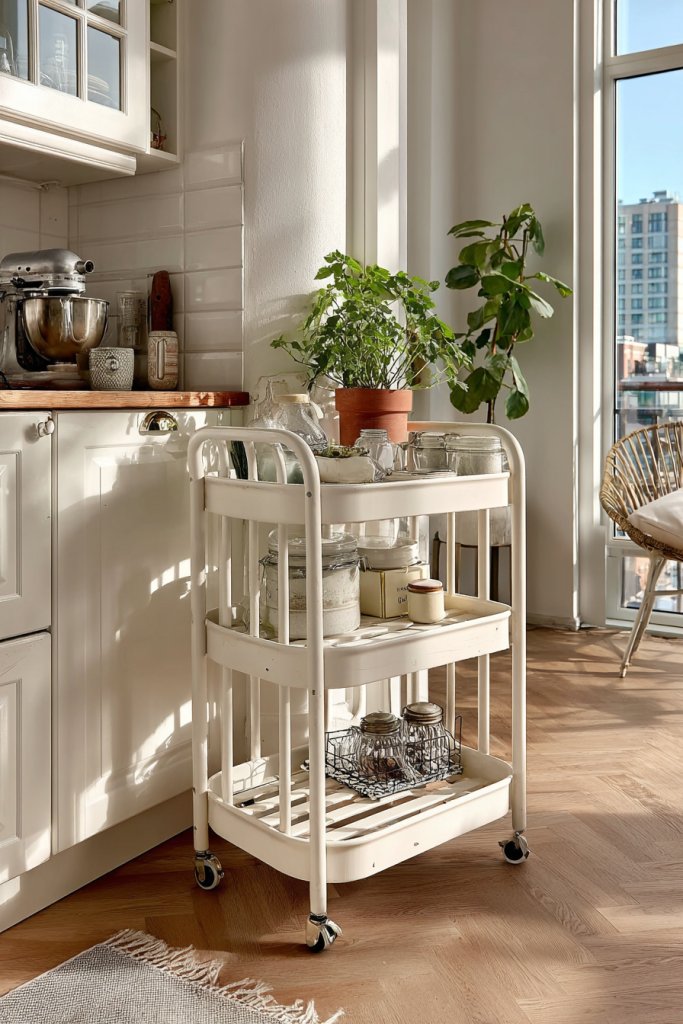
Limited space often restricts your options for storage and surfaces. Compact rolling carts offer a versatile solution that can be moved around easily. Use them as side tables, storage units, or mobile workstations—all in one. Who says small rooms can’t be flexible?
Imagine a sleek metal cart with multiple tiers, holding a mix of office supplies, craft materials, or snacks. It glides smoothly on casters, easily repositioned to suit your activity. When not in use, it can be tucked away or rolled into a corner. Its minimalist design complements modern decor, adding both form and function.
Select carts with waterproof surfaces or decorative finishes to match your style. Use baskets or trays on each tier for organization. Incorporate adjustable heights or removable shelves for customization. Use multiple carts in different zones for dedicated storage—kitchen, craft, or office. Seasonal or project-based swaps keep things fresh.
Identify the storage needs and measure available space. Choose a sturdy, lightweight cart with enough tiers to hold your essentials. Securely assemble if required, and test mobility and stability. Organize items logically—by type or frequency of use. Keep the cart clean and check for wear periodically. Use wall anchors if extra stability is needed.
Decorate with colorful contact paper or paint for a custom look. Add labels or tags to keep things organized. Include small decorative elements like faux plants or decorative trays—avoiding overused vases or artwork. Use it as a mobile bar, craft station, or side table, depending on your needs.
Rolling carts bring flexibility and style to small rooms, proving that functionality can be sleek and fun. They adapt to your changing needs and maximize every inch of space. With a little creativity, your room becomes a dynamic, efficient zone. Start rolling and organizing today!
19. Wall-Mounted Hooks and Racks for Easy Organization
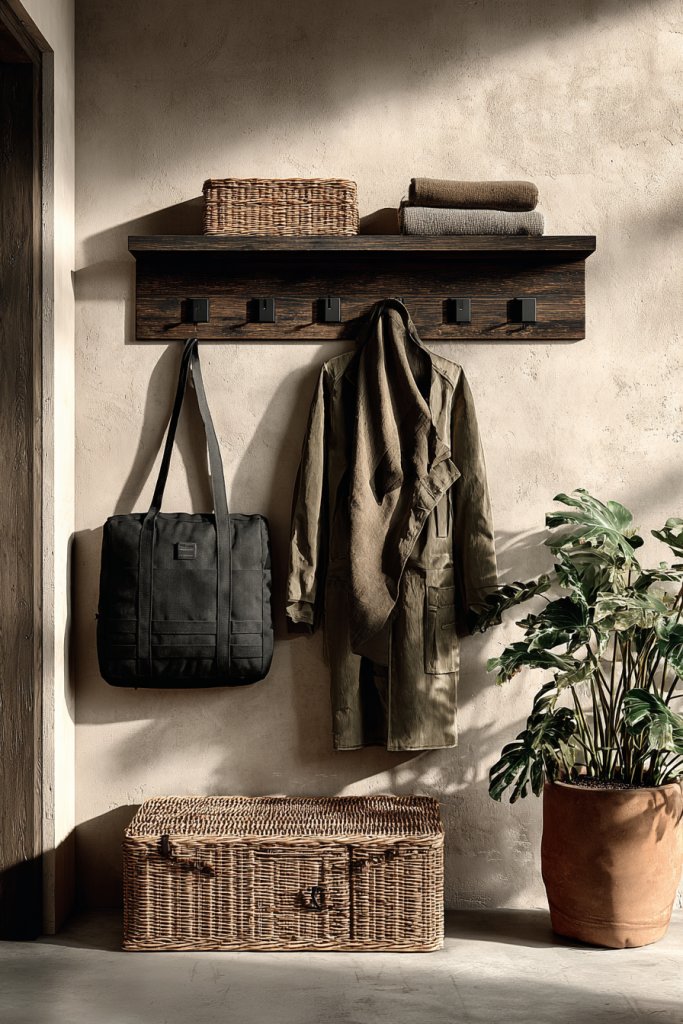
Cluttered surfaces and crowded floors make small rooms feel chaotic. Wall-mounted hooks and racks instantly clear space, providing a dedicated spot for coats, bags, or accessories. They keep essentials accessible and your room looking tidy. Who wants a messy entry or corner?
Picture a row of sleek, matte black hooks mounted near the door, holding jackets, umbrellas, and hats. A stylish wooden rack above the bed stores bags or scarves, adding texture and functionality. The walls become a practical display, reducing clutter and creating a clean aesthetic. It’s an organized, welcoming space.
Choose from minimalist metal hooks, decorative ceramic knobs, or multifunctional racks with shelves. Install at different heights for varied items—small hooks for keys, larger ones for coats. Use color or finish to match your decor, and mix functional with decorative elements. Seasonal reorganization keeps it fresh and practical.
Identify high-traffic areas where hooks are most needed. Mark placement points with a pencil, then secure hooks or racks into studs or anchors. Distribute weight evenly to prevent damage. Keep frequently used items within easy reach. Regularly check for stability and tighten as necessary. Use labels or decorative tags for a personalized touch.
Decorate hooks with painted or themed covers for a customized feel. Use decorative ribbons or trims to add personality. Incorporate small baskets or pouches attached to racks for extra storage. Organize seasonally—swap out items or reconfigure hooks to match your changing needs. The aim is functional beauty.
Wall hooks and racks are simple yet effective, turning blank walls into organized zones. They help you keep your space tidy and stylish without taking up floor space. With a little effort, you’ll create a more functional, welcoming home. Ready to hang up your clutter?
20. Use of Area Rugs to Define Zones and Add Warmth

Small rooms often lack clear boundaries, making the space feel disjointed. Area rugs define zones—like a reading corner or workspace—adding structure and warmth. They also soften hard floors and create a cozy atmosphere. Who doesn’t want to walk into a room that feels inviting?
Imagine a large, soft cream rug anchoring a seating area, with a contrasting geometric pattern defining the workspace. The textures and colors add depth and personality, making each zone distinct yet harmonious. The rug absorbs sound and provides comfort underfoot. It visually separates functional areas for better flow.
Choose rugs in neutral tones for a calming effect or bold patterns for visual interest. Use different sizes to delineate multiple zones—large rugs for main areas, smaller ones for reading nooks. Layer rugs for a textured, eclectic look, or keep it simple for a modern vibe. Seasonal textiles can refresh the look.
Measure your space carefully to select the right rug size. Lay the rug in the intended zone, ensuring it fits comfortably without crowding other furniture. Use non-slip pads underneath for safety, especially on smooth floors. Keep the rug clean and vacuum regularly to maintain its appearance. Reposition as needed for best effect.
Add decorative edges or trims for a personalized touch. Use rugs with subtle patterns or textures that complement your decor palette. Incorporate small cushions or throws nearby to unify the look. Seasonal updates through different textiles can keep your space fresh and inviting.
Area rugs are a simple way to transform tiny rooms into structured, cozy retreats. They define spaces and add style without major renovations. With a few choices, your room will feel larger and more organized. Start laying down your new favorite rug today!
21. Customized Built-In Storage Solutions to Maximize Space

Off-the-shelf furniture might not fit your small room perfectly, leaving dead space or cluttered corners. Customized built-in storage offers a tailored solution, fitting precisely where you need it most. It maximizes every inch and keeps your space looking sleek and organized. Who doesn’t want a room that feels made for them?
Imagine a custom wall unit with open shelves, cabinets, and drawers, designed to fit your exact needs. It incorporates a desk area, display niches, and hidden compartments, all seamlessly integrated into the room’s architecture. The finish matches your decor, creating a cohesive, clutter-free environment. It’s like having a bespoke furniture piece that serves multiple functions.
Work with a carpenter or custom furniture maker to design storage tailored to your lifestyle—whether it’s a compact wardrobe, media wall, or multi-purpose unit. Use materials like wood, MDF, or laminate to suit your style and budget. Incorporate adjustable shelves and removable panels for flexibility. Personalize with paint, stain, or decorative hardware.
Start by assessing your space and storage needs thoroughly. Sketch or consult a professional to design the unit, ensuring it fits perfectly and maximizes utility. Measure carefully and plan for electrical outlets or lighting if needed. Hire a skilled craftsman for precise installation. Finish with hardware and accessories that match your decor.
Add decorative accents like painted panels or textured finishes. Incorporate hidden compartments or pull-out trays for special items. Use labels or color coding to organize small items. Incorporate lighting or reflective surfaces to enhance functionality. Personal touches make your built-in a reflection of your style.
Custom built-ins turn your small room into a highly functional, stylish space. They offer tailored solutions that maximize storage and aesthetics simultaneously. With expert help and a clear vision, you’ll have a room that feels spacious and personalized. Time to dream big within small spaces!
22. Clutter-Free Surfaces with Minimalist Accessories
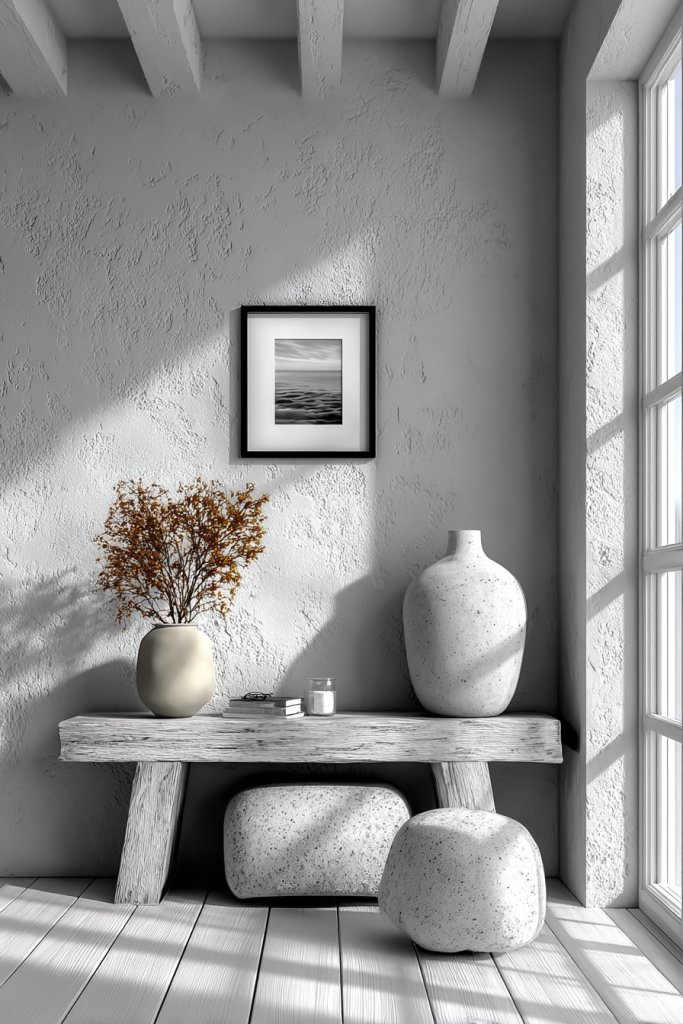
Surfaces filled with clutter make small rooms look chaotic and overwhelming. Minimalist accessories keep surfaces clean and functional, creating a calm environment. Less visual noise means more perceived space and tranquility. Who doesn’t want a peaceful, uncluttered room?
Visualize a sleek coffee table with only a single decorative tray and a small sculpture, avoiding overcrowding. A tidy desk with a minimalist organizer and a single pen holder keeps essentials within reach. The surfaces are intentionally kept sparse but thoughtfully decorated, emphasizing quality over quantity. This approach makes the room look larger and more curated.
Use simple, functional accessories—like ceramic dishes, textured trays, or geometric bowls—in neutral tones or subtle colors. Limit decorative objects to a few statement pieces. Rotate accessories seasonally or for special occasions to keep the look fresh. Avoid overdecorating and focus on quality, meaningful pieces.
Clear surfaces regularly to prevent buildup of clutter. Select accessories that serve a purpose and match your decor. Use trays or bowls to corral small items, and opt for multi-purpose pieces like storage boxes that also look stylish. Keep cords hidden with cable clips. Regular maintenance keeps surfaces looking clean and intentional.
Personalize with textured fabrics, handmade items, or one-of-a-kind decor pieces. Incorporate natural elements like stones or wood for warmth, avoiding overused art or vases. Use consistent color schemes to unify the look. Small, meaningful accents make a big impact without clutter.
A clutter-free surface reflects a calm, organized mind. It’s a simple step toward a more spacious and stylish home. With intentional choices, your small room becomes a serene retreat that invites relaxation and focus. Less truly is more—start decluttering today!
23. Sliding Doors or Pocket Doors to Save Door Swing Space
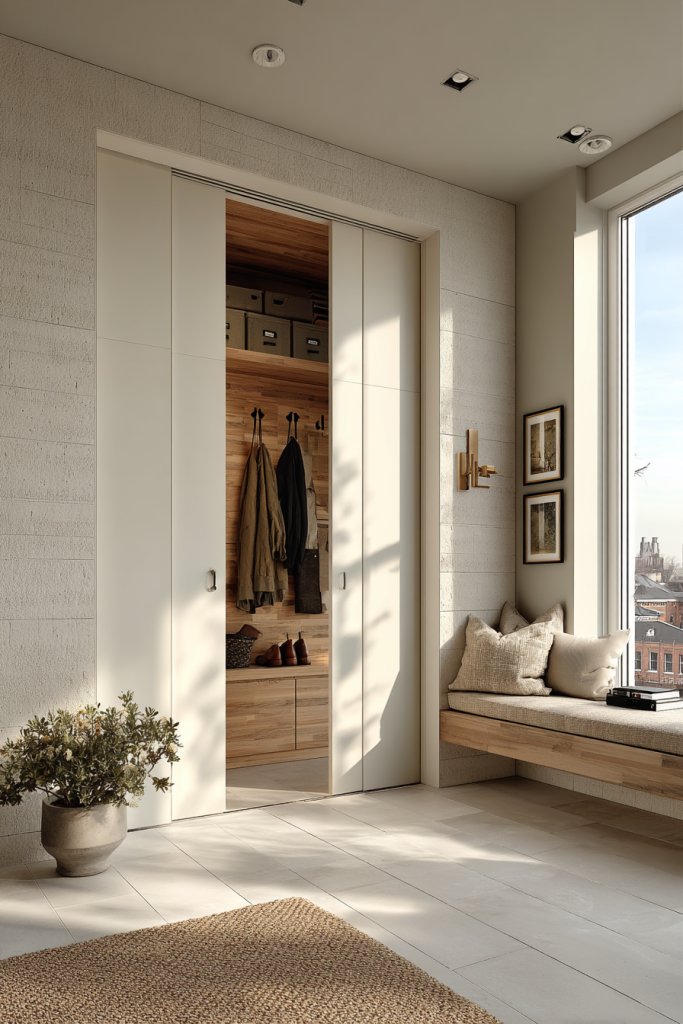
Traditional doors swing into small rooms, wasting space and creating obstacles. Sliding or pocket doors slide neatly into walls, freeing up precious floor area. They’re perfect for small spaces where every inch counts. Who wants a door that gets in the way?
Imagine a sleek, matte black sliding door that seamlessly glides open to reveal a compact closet or bathroom. When closed, it becomes part of the wall, maintaining a clean, minimalist look. The smooth operation and hidden track give the room an uncluttered, modern vibe. It’s a small change with a big impact.
Choose from different materials—wood veneer, frosted glass, or painted panels—to match your decor. Install in places where swing doors would normally block access or take up space. Use trackless or concealed track systems for a seamless appearance. Seasonal or temporary reconfigurations are easy with portable options.
Measure door openings carefully and select the appropriate sliding or pocket door system. Hire a professional to ensure proper installation, especially for concealed track systems. Prepare the wall cavity or framing for smooth operation. Seal edges and test the door regularly to prevent sticking or misalignment. Keep hardware clean and lubricated.
Decorate doors with paint, wallpaper, or textured finishes that complement your room. Add handles or pulls that fit your style—modern, vintage, or minimalist. Use the space beside the door for small shelves or hooks, avoiding clutter around the sliding mechanism. Seasonal color updates can refresh the look.
Sliding and pocket doors redefine small room functionality and style. They eliminate space-wasting swings and provide sleek, versatile entry solutions. With professional installation, you gain a seamless, clutter-free environment. It’s an upgrade that combines practicality with design elegance.
24. Modular Furniture Pieces that Can Be Reconfigured
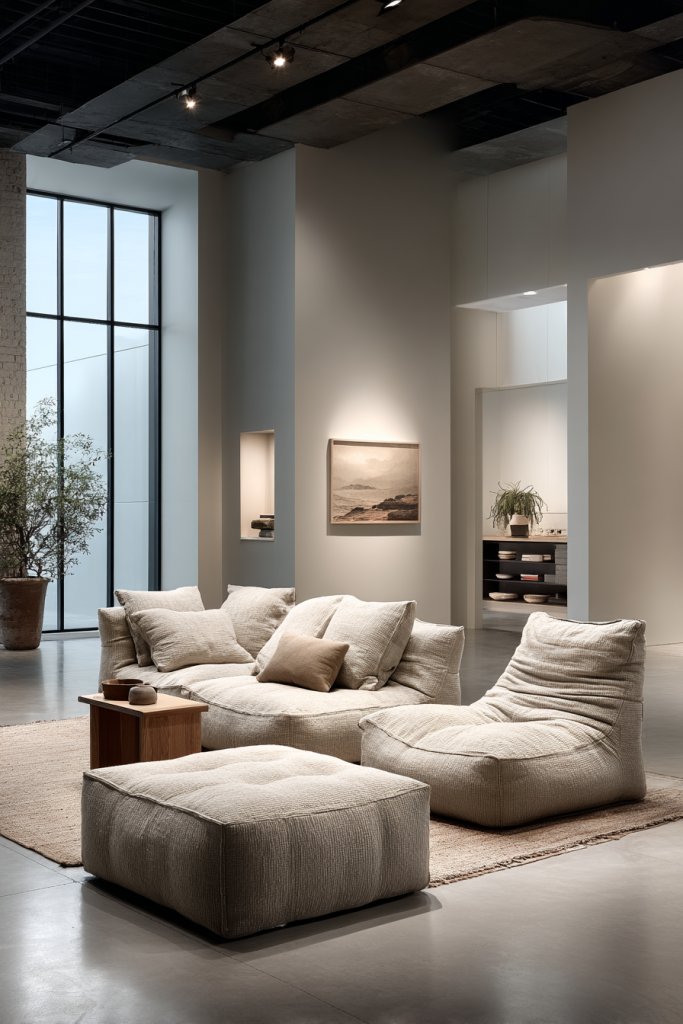
Fixed furniture can limit your options in a small space, making it hard to adapt to changing needs. Modular furniture offers reconfigurable solutions that grow with you. Combine, split, or rearrange pieces for different functions and layouts. Who says small rooms have to be static?
Picture a set of modular cubes that can serve as seating, tables, or storage units. They can be stacked vertically or spread out horizontally, creating different configurations for lounging, working, or dining. The neutral tones and clean lines fit various styles, from modern to eclectic. This flexibility transforms your space into a dynamic environment.
Choose pieces with multiple connection points—clips, magnets, or brackets—for easy reassembly. Use different finishes or colors to define zones or add personality. Incorporate wheels or fold-away mechanisms for extra mobility. Seasonal or activity-based reconfigurations keep the space functional and fresh.
Start by assessing your space and identifying your needs. Select modular pieces that can be combined in multiple ways. Follow manufacturer instructions for assembly, ensuring stability. Use lightweight, durable materials like plastic or thin wood for easy reconfiguration. Store extra pieces in a dedicated space for quick changes.
Customize modules with paint, decals, or fabric covers to match your decor. Add cushions or soft textiles for comfort. Use labels or color coding to keep track of different configurations. Incorporate lighting or decorative accents to enhance visual appeal. The goal is an adaptable, stylish setup.
Modular furniture proves that flexibility and style can coexist in small spaces. It allows you to personalize your environment and adjust as your needs change. With clever design, your room remains functional, fun, and fresh. Ready to reconfigure your space on demand?
25. Strategic Use of Niche Spaces and Recessed Areas
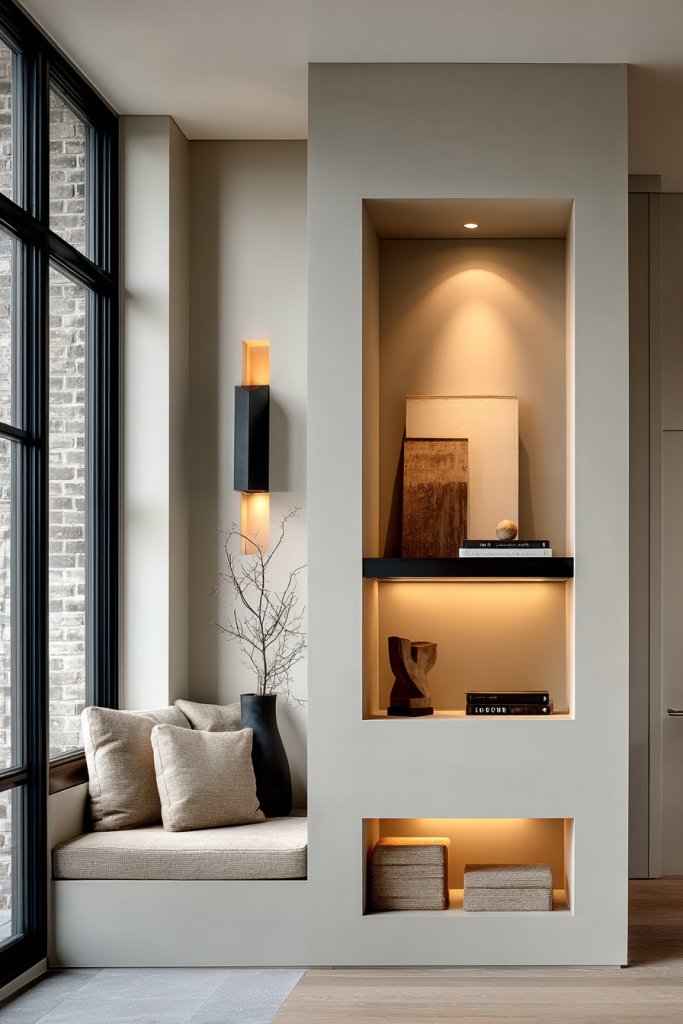
Unused wall niches or recessed areas are often overlooked, wasting valuable space. Strategically utilizing these spots can add hidden storage, display, or seating. It’s a smart way to maximize every inch without crowding the main area. Who knew small spaces could be so clever?
Imagine a shallow wall niche painted in a bold accent color, holding a few decorative objects or books. Recessed shelves built into a wall provide storage for everyday essentials. A cozy built-in seat with cushions fits perfectly into a small alcove, offering a quiet retreat. These features add character and function seamlessly.
Use different depths and finishes—wood, plaster, or tile—for niches depending on purpose. Incorporate lighting within recesses to highlight display items or add ambiance. Use built-in drawers or baskets for concealed storage. Seasonal or thematic decor can be swapped easily, keeping the space lively.
Identify suitable niches or alcoves and measure dimensions carefully. Consult a contractor or DIY with proper tools to build shelves or seating. Finish with paint, stain, or tile to match your decor. Install lighting or electrical outlets if needed. Organize inside with baskets, bins, or small containers for maximum efficiency.
Decorate with decorative tiles, textured paints, or wallpaper inside niches to add visual interest. Use cushions or throws to make built-in seating inviting. Incorporate small plants or unique objects to personalize. Seasonal updates or rearrangements keep the space fresh and engaging.
Recessed areas turn overlooked spaces into stylish, functional features. They add depth and character to small rooms, making them feel more designed and intentional. With a little planning, your space becomes more personalized and efficient. Start exploring those hidden corners today!
Conclusion
Exploring these diverse small room design ideas opens up exciting possibilities for transforming your space. Whether it’s through innovative storage solutions, clever layouts, or eye-catching decor, each idea is a step toward a more functional and stylish home. Don’t hesitate to try out these tips and make your small space work beautifully for you—your dream room is just a design away!